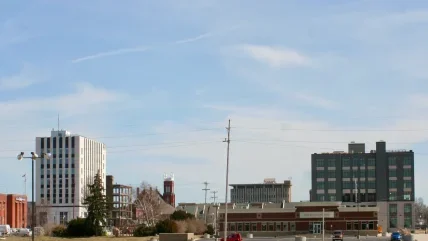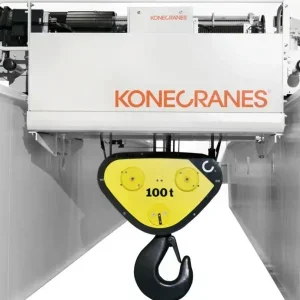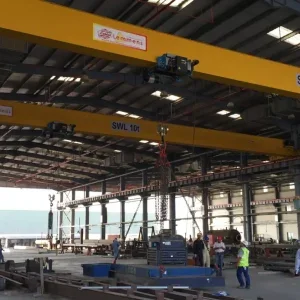
Thomas Weston, Alton Shaw and Alfred Box are among the founding fathers of the modern industrial lifting industry, and their enterprise eventually all came together in the US company Yale Lift-Tech. The near-150 year history of Yale Lift-Tech may not quite match the 258 year history of Germany’s JD Neuhaus, but its heritage is one that is well worth honouring.
In 1854 Thomas A Weston of England invented the differential pulley block, which gave lifters far greater power, control and safety than ever before. Its operating principle was so sound, the basic design continues to be used more than 150 years later. In 1876 the Yale Lock Company acquired the patent rights to the differential pulley block and began production. Ten years after making the Yale Triplex Spur-Gear Block hoist (shown left), Yale had become a recognised leader in industrial hoists, a position it still maintains today.
At about the same time, in the 1880s, Alton J Shaw a draughtsman with the Edwin P Allis Company in Milwaukee, USA, applied his mind to improving the cranes of the day that comprised a steam engine and flying ropes, with complicated gearing and controls. Shaw’s idea was for three separate reversible electric motors, one to drive the hoist, one for the trolley’s cross travel and one for the crane’s long travel. He built the first one for his employer, Allis, and attracted the attention of other crane manufacturers.
In 1880 Shaw set up in business with his friend John Emery Jr. Shaw’s second crane went to the William’s Engine Works, which made the Beloit wind engine. Number three, built in 1888, went to the Union Pacific Railroad in Cheyenne, Wyoming and as is still in use today. By the end of 1889 Shaw had sold and designed 30 cranes, the manufacture of which was subcontracted to a small machine shop in Milwaukee called Pauling & Harnischfeger (P&H).
The Shaw Electric Crane Company was formed in 1890 and moved from Milwaukee to Muskegon, Michigan where it remains to this day, in the very same building (although extensions and additions have changed it over the years).
Rather than setting up its own sales force to sell the cranes, Shaw Electric Crane Company appointed Manning, Maxwell & Moore as its exclusive sales agent and in 1905 the agent took over ownership of the crane manufacturer.
During the decades that followed, both Shaw-Box and Yale carved out strong market niches. Yale introduced new hoists, like the Model 20 of 1907 and the Model SS of 1913, which made lifting faster, safer and cheaper. Shaw cranes and hoists were installed in thousands of factories, mills, mines, and loading facilities.
A third company had also established itself. Alfred E Box Crane & Hoist Corporation had been founded in Philadelphia in 1877 and had in 1921 developed the first electric package hoist, the Load Lifter.
In 1932 Manning, Maxwell & Moore acquired Box and merged it with Shaw in Muskegon to create Shaw-Box Crane & Hoist Company.
Three years later, the company introduced Budgit, the first portable electric chain hoist. The Budgit line was an immediate success, selling well, even in the depths of the depression. Another Shaw-Box innovation was the Tugit lever operated chain hoist, which would become an essential tool for workers around the world. Both lines, updated over the years, are still in production.
During World War II, Yale and Shaw-Box cranes and hoists were essential to the production of everything from combat boots to battleships. When industry moved back to a peacetime footing, factories placed even more orders with Yale and Shaw-Box. Yale had several standout products during this period: Cable King electric wire rope monorail hoists, MEL Midget King electric chain hoists, and PE ratchet lever hoists. In addition to its Budgit and Tugit hoists, Shaw-Box installed thousands of bridge cranes and hoists.
In 1964 Shaw-Box Crane & Hoist was taken over by Dresser Industries, an architypal sixties conglomerate, and became Dresser Crane & Hoist.
To mark the bicentenary of the USA in 1976 the company switched from yellow paint to blue for the hoists and trolleys, while the bridges were painted red with white eagles. After that year’s celebrations were over, the bridge girders reverted to yellow, but the hoists remained blue as standard.
In the early and mid 1980s sales declined as the market deteriorated. In 1986 a group of private investors took ownership from Dresser, changed the company name to Lift-Tech International, and changed strategy. Lift-Tech stopped building cranes but instead supplied hoists, end trucks and other components to crane builders.
Yale, meanwhile, continued to operate independently up through the mid-1990s, producing a wide range of hoists in its plant in Forrest City, Arkansas.
Yale and Lift-Tech came together in 1996, when both companies were acquired by Columbus McKinnon, a corporation with its own 120-year background in materials handling. As a result, both the Yale and Lift-Tech lines are today manufactured at the Muskegon facility, which has now produced cranes and hoists in three different centuries.
History on display
With more than 200 combined years of hoist and crane manufacturing between the constituent companies, Yale Lift-Tech has a lot of history behind its name. And now the company has put it on display for its employees, customers, and the local community. It has established a museum that summarises and celebrates the company’s extensive history – along with the technologies and innovations that have kept Yale Lift-Tech and its predecessors in the materials handling industry since the 1850s.
The Yale Lift-Tech Heritage Center displays a wide range of products, advertisements and other memorabilia from the archives of Lift-Tech, Shaw-Box and Yale.
“Yale Lift-Tech has a truly unique background, one that never fails to impress people,” says Greg Miskowiec, Yale Lift-Tech’s product manager.
“Unfortunately, only a few people, both inside and outside our company, were aware of it. So we decided to make our history more accessible by putting it on display.”
According to Miskowiec, the Heritage Center is directed towards three groups. “Obviously, we wanted our customers to know about our record of accomplishments. But we also wanted our own people to see that they are the latest part of a long and distinguished tradition, that they can take great pride in their company. And we also intend the Center to be for our community. Our roots run deep here, and over the past 100-plus years, the company has touched a lot of lives throughout the area. Now that we have the Center, we can do a much better job of communicating our history to everyone.”
To a large extent, the history shown at the Heritage Center is also the history of industrial lifting in North America – all the way back to the revolutionary Weston pulley.
“We’ve created a lot of history here,” says Miskowiec. “And with the new products and technologies we’re developing, we will be making even more history in the future.”






